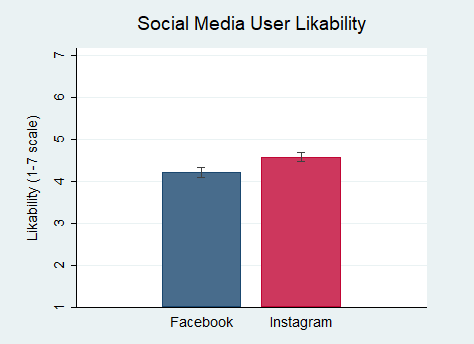Overview
As we covered in our previous experiment, Twitter vs. TikTok, over 50% of people in the world use social media. But it’s a fragmented field. Different platforms cater to different groups of people with different preferences.
Facebook, for example, encourages users to build profiles with text, photos, and to a lesser extent videos, while sharing life events, thoughts, opinions, and other types of posts. Instagram, on the other hand, primarily focuses on creative content in the form of photos and video. Facebook’s audience skews a bit older than Instagram’s. Facebook acquired Instagram in 2012.
To build on our fun series of experiments about social media preferences, we tested the likability of people who express a preference for using Facebook vs. Instagram.
The Experiment
We conducted an experiment with 400 people on Amazon Mechanical Turk in which participants were told about a hypothetical new acquaintance and their favorite social media platform, either Facebook or Instagram, randomly assigned.
Participants were instructed to “Imagine that you and a new acquaintance are talking about social media, and they mention that their favorite social media platform is [Facebook / Instagram].”
Participants were then asked “How much do you like this person? (1 = Not at all, 7 = Extremely)” using a 1-7 scale.
Results
We found a small yet statistically significant difference in likability ratings such that our Facebook user was liked slightly less (avg. = 4.23) than our Instagram user (avg. = 4.59), (p = 0.027). However, much like our Twitter vs. TikTok experiment, this was a small difference by statistical standards. The difference was slightly less than a quarter of a standard deviation. There were no significant interactions with age or gender.
As we covered in our previous experiment, Twitter vs. TikTok, over 50% of people in the world use social media. But it’s a fragmented field. Different platforms cater to different groups of people with different preferences.
Facebook, for example, encourages users to build profiles with text, photos, and to a lesser extent videos, while sharing life events, thoughts, opinions, and other types of posts. Instagram, on the other hand, primarily focuses on creative content in the form of photos and video. Facebook’s audience skews a bit older than Instagram’s. Facebook acquired Instagram in 2012.
To build on our fun series of experiments about social media preferences, we tested the likability of people who express a preference for using Facebook vs. Instagram.
The Experiment
We conducted an experiment with 400 people on Amazon Mechanical Turk in which participants were told about a hypothetical new acquaintance and their favorite social media platform, either Facebook or Instagram, randomly assigned.
Participants were instructed to “Imagine that you and a new acquaintance are talking about social media, and they mention that their favorite social media platform is [Facebook / Instagram].”
Participants were then asked “How much do you like this person? (1 = Not at all, 7 = Extremely)” using a 1-7 scale.
Results
We found a small yet statistically significant difference in likability ratings such that our Facebook user was liked slightly less (avg. = 4.23) than our Instagram user (avg. = 4.59), (p = 0.027). However, much like our Twitter vs. TikTok experiment, this was a small difference by statistical standards. The difference was slightly less than a quarter of a standard deviation. There were no significant interactions with age or gender.
Conclusion
There you have it. Instagram wins. Though the victory was far from a landslide. Still, it might point to social media users’ changing preferences for platforms focused on image and video content. Or it could be partially driven by the growing animosity toward the Facebook (now Meta) company, and the platform tied to its name. These are interesting subjects for future research.
There you have it. Instagram wins. Though the victory was far from a landslide. Still, it might point to social media users’ changing preferences for platforms focused on image and video content. Or it could be partially driven by the growing animosity toward the Facebook (now Meta) company, and the platform tied to its name. These are interesting subjects for future research.
Methods Note
We used an independent samples t-test to test for significant differences in perceptions between our two experimental conditions. For significant differences, the difference between the two groups' averages would be large and its corresponding “p-value” would be small. If the p-value is less than 0.05, we consider the difference statistically significant, meaning we'd likely find a similar effect if we ran the study again with this population. To test for significant interactions between the main results and participant demographics, we used OLS regression analyses with interaction terms.
Methods Note
We used an independent samples t-test to test for significant differences in perceptions between our two experimental conditions. For significant differences, the difference between the two groups' averages would be large and its corresponding “p-value” would be small. If the p-value is less than 0.05, we consider the difference statistically significant, meaning we'd likely find a similar effect if we ran the study again with this population. To test for significant interactions between the main results and participant demographics, we used OLS regression analyses with interaction terms.
Popular Experiments
COVID MasksDoes wearing a COVID mask affect how others think of you?
|
Video GamesAre video games more enjoyable than board games?
Does age or gender matter? |
Zero-Sum PoliticsDo Democrats or Republicans view society as win-lose?
|




